towing BMW 328D XDRIVE SEDAN 2014 Owners Manual
[x] Cancel search | Manufacturer: BMW, Model Year: 2014, Model line: 328D XDRIVE SEDAN, Model: BMW 328D XDRIVE SEDAN 2014Pages: 242, PDF Size: 7.25 MB
Page 41 of 242
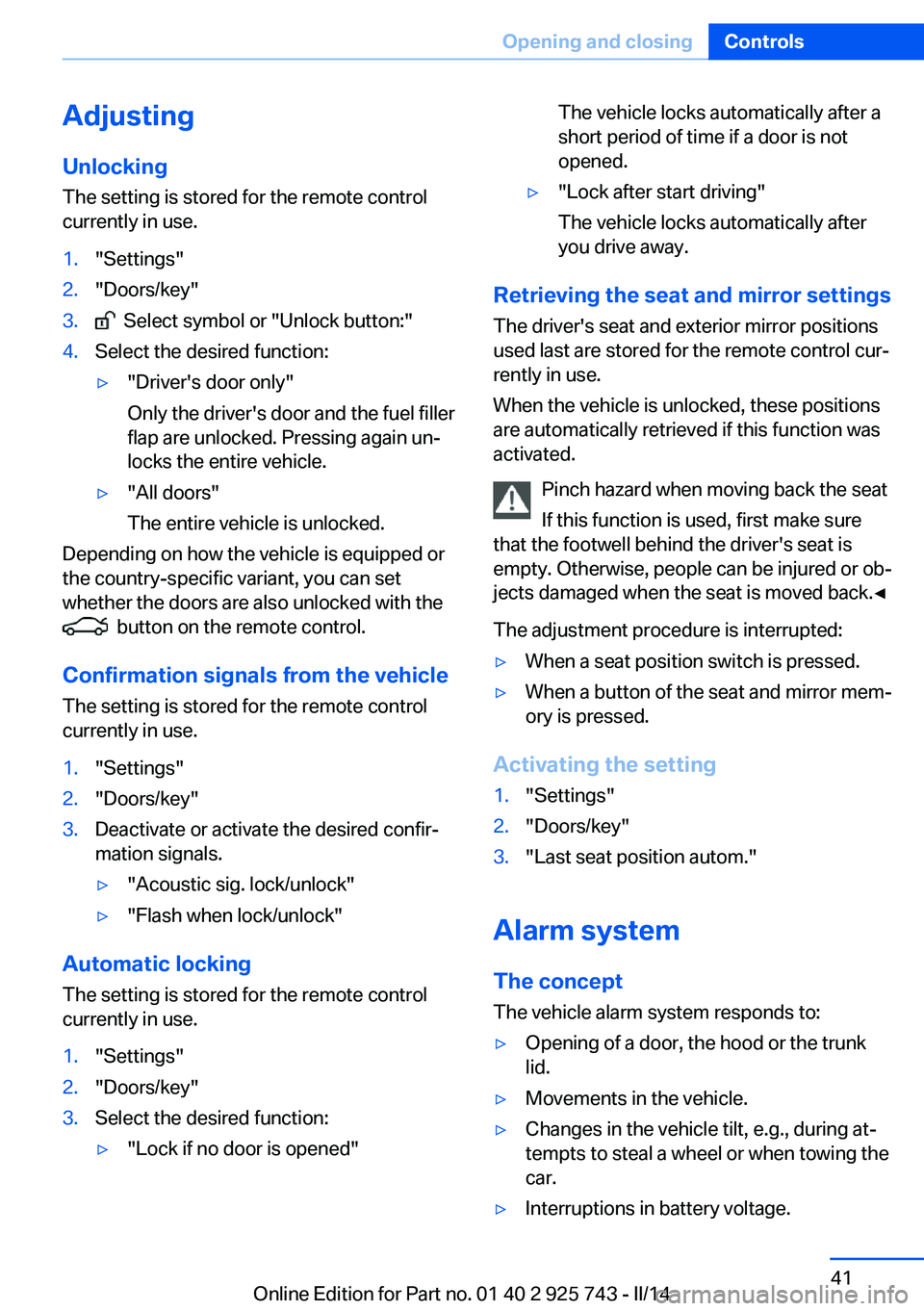
Adjusting
Unlocking The setting is stored for the remote control
currently in use.1."Settings"2."Doors/key"3. Select symbol or "Unlock button:"4.Select the desired function:âˇ"Driver's door only"
Only the driver's door and the fuel filler
flap are unlocked. Pressing again unâ
locks the entire vehicle.âˇ"All doors"
The entire vehicle is unlocked.
Depending on how the vehicle is equipped or
the country-specific variant, you can set
whether the doors are also unlocked with the
button on the remote control.
Confirmation signals from the vehicle
The setting is stored for the remote control
currently in use.
1."Settings"2."Doors/key"3.Deactivate or activate the desired confirâ
mation signals.âˇ"Acoustic sig. lock/unlock"âˇ"Flash when lock/unlock"
Automatic locking
The setting is stored for the remote control
currently in use.
1."Settings"2."Doors/key"3.Select the desired function:âˇ"Lock if no door is opened"The vehicle locks automatically after a
short period of time if a door is not
opened.âˇ"Lock after start driving"
The vehicle locks automatically after
you drive away.
Retrieving the seat and mirror settings
The driver's seat and exterior mirror positions
used last are stored for the remote control curâ
rently in use.
When the vehicle is unlocked, these positions
are automatically retrieved if this function was
activated.
Pinch hazard when moving back the seat
If this function is used, first make sure
that the footwell behind the driver's seat is
empty. Otherwise, people can be injured or obâ
jects damaged when the seat is moved back.â
The adjustment procedure is interrupted:
âˇWhen a seat position switch is pressed.âˇWhen a button of the seat and mirror memâ
ory is pressed.
Activating the setting
1."Settings"2."Doors/key"3."Last seat position autom."
Alarm system
The conceptThe vehicle alarm system responds to:
âˇOpening of a door, the hood or the trunk
lid.âˇMovements in the vehicle.âˇChanges in the vehicle tilt, e.g., during atâ
tempts to steal a wheel or when towing the
car.âˇInterruptions in battery voltage.Seite 41Opening and closingControls41
Online Edition for Part no. 01 40 2 925 743 - II/14
Page 105 of 242
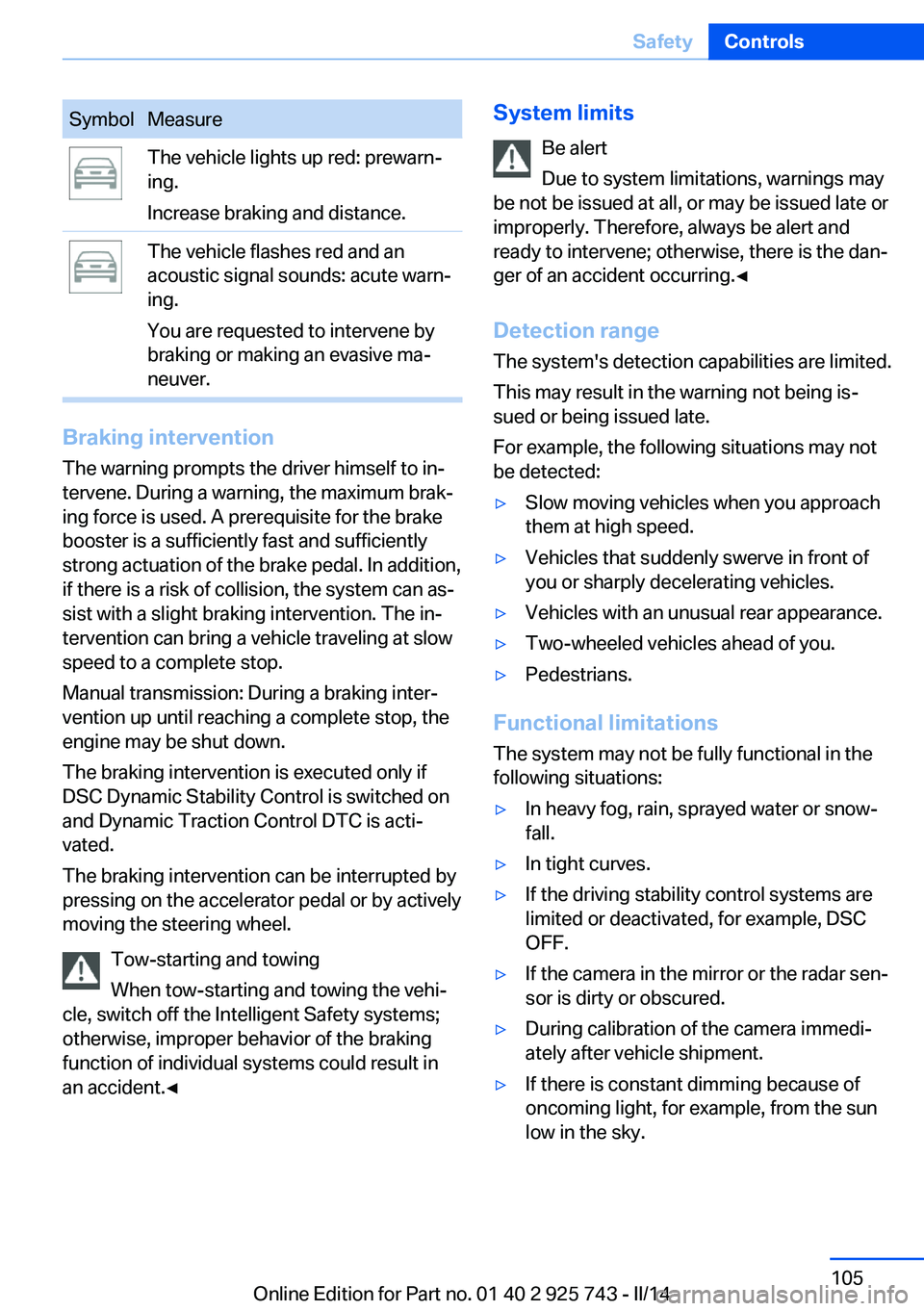
SymbolMeasureThe vehicle lights up red: prewarnâ
ing.
Increase braking and distance.The vehicle flashes red and an
acoustic signal sounds: acute warnâ
ing.
You are requested to intervene by
braking or making an evasive maâ
neuver.
Braking intervention
The warning prompts the driver himself to inâ
tervene. During a warning, the maximum brakâ
ing force is used. A prerequisite for the brake
booster is a sufficiently fast and sufficiently
strong actuation of the brake pedal. In addition,
if there is a risk of collision, the system can asâ
sist with a slight braking intervention. The inâ tervention can bring a vehicle traveling at slow
speed to a complete stop.
Manual transmission: During a braking interâ
vention up until reaching a complete stop, the
engine may be shut down.
The braking intervention is executed only if
DSC Dynamic Stability Control is switched on
and Dynamic Traction Control DTC is actiâ
vated.
The braking intervention can be interrupted by
pressing on the accelerator pedal or by actively
moving the steering wheel.
Tow-starting and towing
When tow-starting and towing the vehiâ
cle, switch off the Intelligent Safety systems;
otherwise, improper behavior of the braking
function of individual systems could result in
an accident.â
System limits
Be alert
Due to system limitations, warnings may
be not be issued at all, or may be issued late or
improperly. Therefore, always be alert and
ready to intervene; otherwise, there is the danâ
ger of an accident occurring.â
Detection range
The system's detection capabilities are limited.
This may result in the warning not being isâ
sued or being issued late.
For example, the following situations may not
be detected:âˇSlow moving vehicles when you approach
them at high speed.âˇVehicles that suddenly swerve in front of
you or sharply decelerating vehicles.âˇVehicles with an unusual rear appearance.âˇTwo-wheeled vehicles ahead of you.âˇPedestrians.
Functional limitations
The system may not be fully functional in the
following situations:
âˇIn heavy fog, rain, sprayed water or snowâ
fall.âˇIn tight curves.âˇIf the driving stability control systems are
limited or deactivated, for example, DSC
OFF.âˇIf the camera in the mirror or the radar senâ
sor is dirty or obscured.âˇDuring calibration of the camera immediâ
ately after vehicle shipment.âˇIf there is constant dimming because of
oncoming light, for example, from the sun
low in the sky.Seite 105SafetyControls105
Online Edition for Part no. 01 40 2 925 743 - II/14
Page 107 of 242
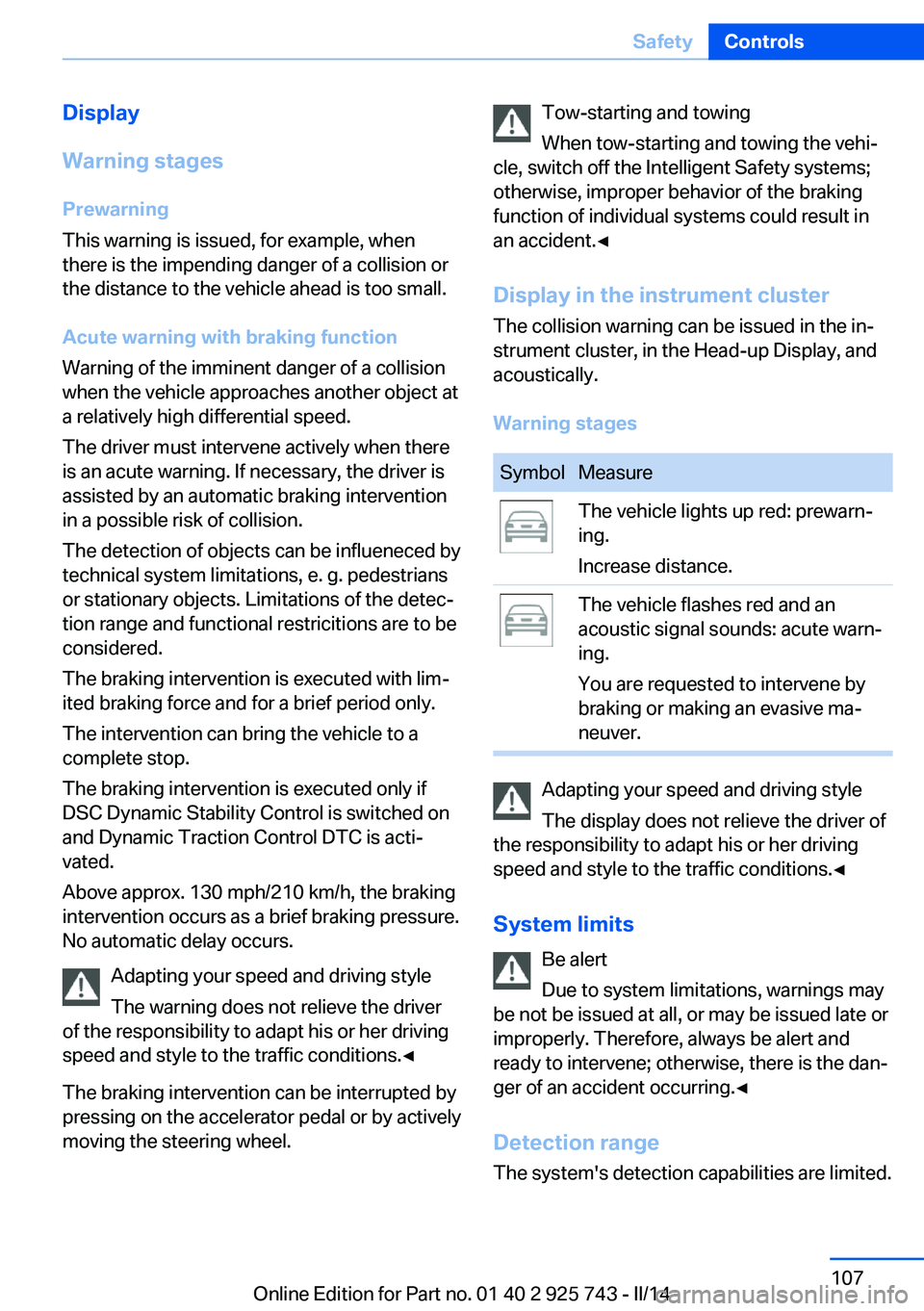
Display
Warning stages
Prewarning
This warning is issued, for example, when there is the impending danger of a collision or
the distance to the vehicle ahead is too small.
Acute warning with braking function
Warning of the imminent danger of a collision
when the vehicle approaches another object at
a relatively high differential speed.
The driver must intervene actively when there
is an acute warning. If necessary, the driver is
assisted by an automatic braking intervention
in a possible risk of collision.
The detection of objects can be influeneced by
technical system limitations, e. g. pedestrians
or stationary objects. Limitations of the detecâ
tion range and functional restricitions are to be
considered.
The braking intervention is executed with limâ
ited braking force and for a brief period only.
The intervention can bring the vehicle to a
complete stop.
The braking intervention is executed only if
DSC Dynamic Stability Control is switched on
and Dynamic Traction Control DTC is actiâ
vated.
Above approx. 130 mph/210 km/h, the braking
intervention occurs as a brief braking pressure.
No automatic delay occurs.
Adapting your speed and driving style
The warning does not relieve the driver
of the responsibility to adapt his or her driving
speed and style to the traffic conditions.â
The braking intervention can be interrupted by
pressing on the accelerator pedal or by actively
moving the steering wheel.Tow-starting and towing
When tow-starting and towing the vehiâ
cle, switch off the Intelligent Safety systems;
otherwise, improper behavior of the braking
function of individual systems could result in
an accident.â
Display in the instrument cluster The collision warning can be issued in the inâ
strument cluster, in the Head-up Display, and
acoustically.
Warning stagesSymbolMeasureThe vehicle lights up red: prewarnâ
ing.
Increase distance.The vehicle flashes red and an
acoustic signal sounds: acute warnâ
ing.
You are requested to intervene by
braking or making an evasive maâ
neuver.
Adapting your speed and driving style
The display does not relieve the driver of
the responsibility to adapt his or her driving
speed and style to the traffic conditions.â
System limits Be alert
Due to system limitations, warnings may
be not be issued at all, or may be issued late or
improperly. Therefore, always be alert and
ready to intervene; otherwise, there is the danâ
ger of an accident occurring.â
Detection range
The system's detection capabilities are limited.
Seite 107SafetyControls107
Online Edition for Part no. 01 40 2 925 743 - II/14
Page 109 of 242
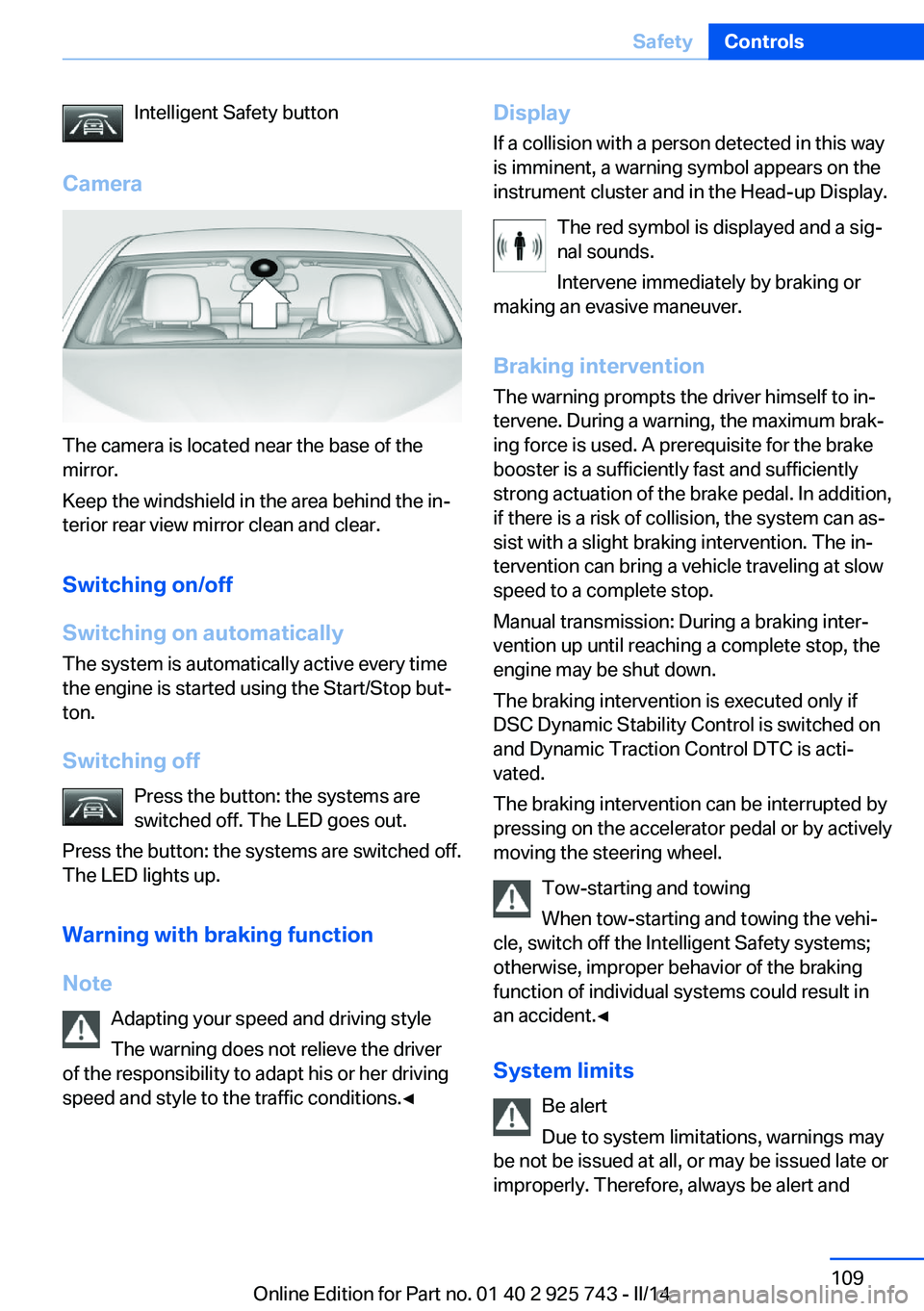
Intelligent Safety button
Camera
The camera is located near the base of the
mirror.
Keep the windshield in the area behind the inâ
terior rear view mirror clean and clear.
Switching on/off
Switching on automatically The system is automatically active every time
the engine is started using the Start/Stop butâ
ton.
Switching off Press the button: the systems are
switched off. The LED goes out.
Press the button: the systems are switched off.
The LED lights up.
Warning with braking function
Note Adapting your speed and driving style
The warning does not relieve the driver
of the responsibility to adapt his or her driving
speed and style to the traffic conditions.â
Display
If a collision with a person detected in this way
is imminent, a warning symbol appears on the
instrument cluster and in the Head-up Display.
The red symbol is displayed and a sigâ
nal sounds.
Intervene immediately by braking or
making an evasive maneuver.
Braking intervention The warning prompts the driver himself to inâ
tervene. During a warning, the maximum brakâ
ing force is used. A prerequisite for the brake
booster is a sufficiently fast and sufficiently
strong actuation of the brake pedal. In addition,
if there is a risk of collision, the system can asâ
sist with a slight braking intervention. The inâ
tervention can bring a vehicle traveling at slow
speed to a complete stop.
Manual transmission: During a braking interâ
vention up until reaching a complete stop, the
engine may be shut down.
The braking intervention is executed only if
DSC Dynamic Stability Control is switched on
and Dynamic Traction Control DTC is actiâ
vated.
The braking intervention can be interrupted by
pressing on the accelerator pedal or by actively
moving the steering wheel.
Tow-starting and towing
When tow-starting and towing the vehiâ
cle, switch off the Intelligent Safety systems;
otherwise, improper behavior of the braking
function of individual systems could result in
an accident.â
System limits Be alert
Due to system limitations, warnings may
be not be issued at all, or may be issued late or
improperly. Therefore, always be alert andSeite 109SafetyControls109
Online Edition for Part no. 01 40 2 925 743 - II/14
Page 156 of 242
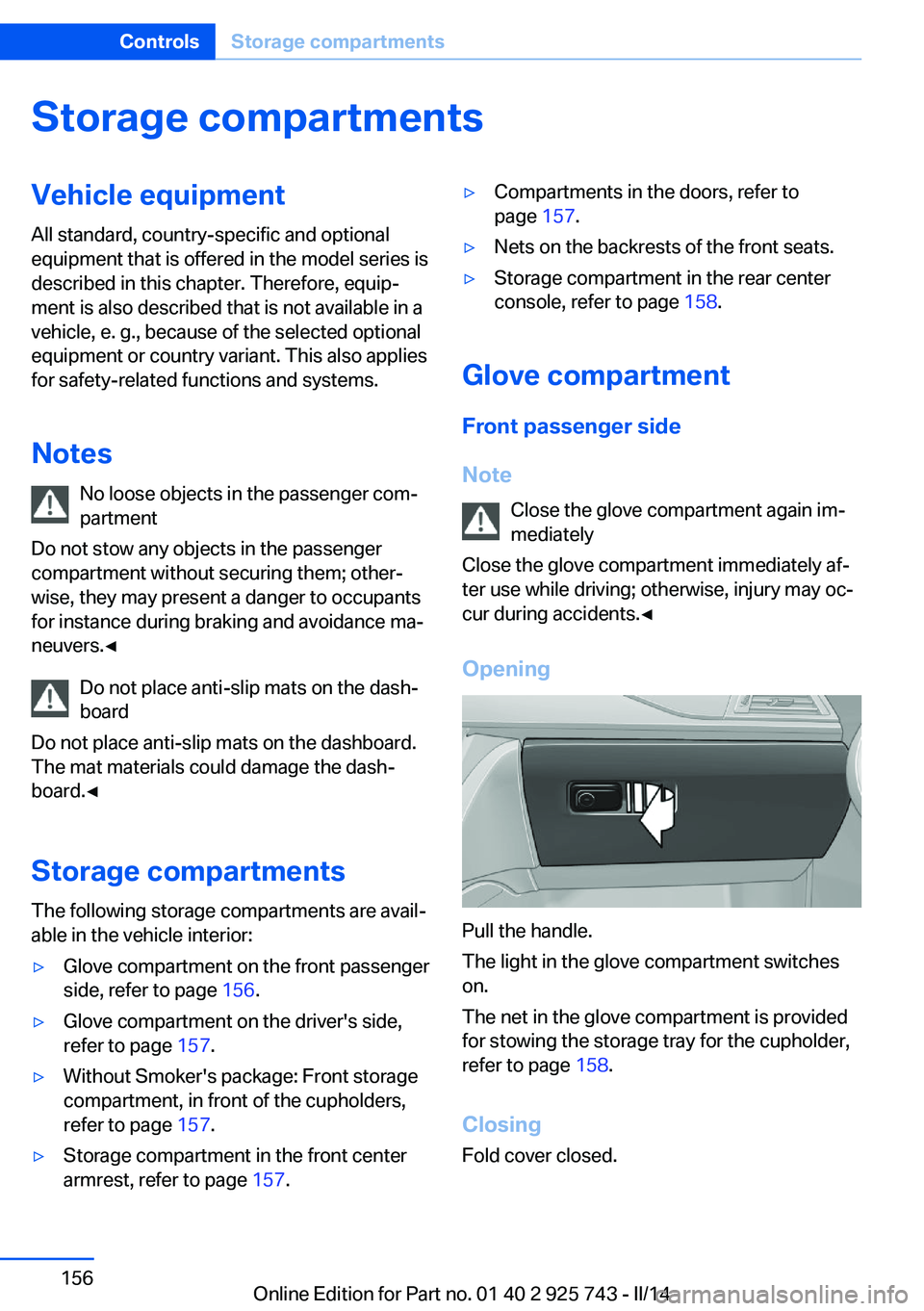
Storage compartmentsVehicle equipmentAll standard, country-specific and optional
equipment that is offered in the model series is
described in this chapter. Therefore, equipâ
ment is also described that is not available in a
vehicle, e. g., because of the selected optional
equipment or country variant. This also applies
for safety-related functions and systems.
Notes No loose objects in the passenger comâ
partment
Do not stow any objects in the passenger
compartment without securing them; otherâ
wise, they may present a danger to occupants
for instance during braking and avoidance maâ
neuvers.â
Do not place anti-slip mats on the dashâ
board
Do not place anti-slip mats on the dashboard.
The mat materials could damage the dashâ
board.â
Storage compartments
The following storage compartments are availâ
able in the vehicle interior:âˇGlove compartment on the front passenger
side, refer to page 156.âˇGlove compartment on the driver's side,
refer to page 157.âˇWithout Smoker's package: Front storage
compartment, in front of the cupholders,
refer to page 157.âˇStorage compartment in the front center
armrest, refer to page 157.âˇCompartments in the doors, refer to
page 157.âˇNets on the backrests of the front seats.âˇStorage compartment in the rear center
console, refer to page 158.
Glove compartment
Front passenger side
Note Close the glove compartment again imâ
mediately
Close the glove compartment immediately afâ
ter use while driving; otherwise, injury may ocâ
cur during accidents.â
Opening
Pull the handle.
The light in the glove compartment switches
on.
The net in the glove compartment is provided
for stowing the storage tray for the cupholder,
refer to page 158.
Closing Fold cover closed.
Seite 156ControlsStorage compartments156
Online Edition for Part no. 01 40 2 925 743 - II/14
Page 166 of 242
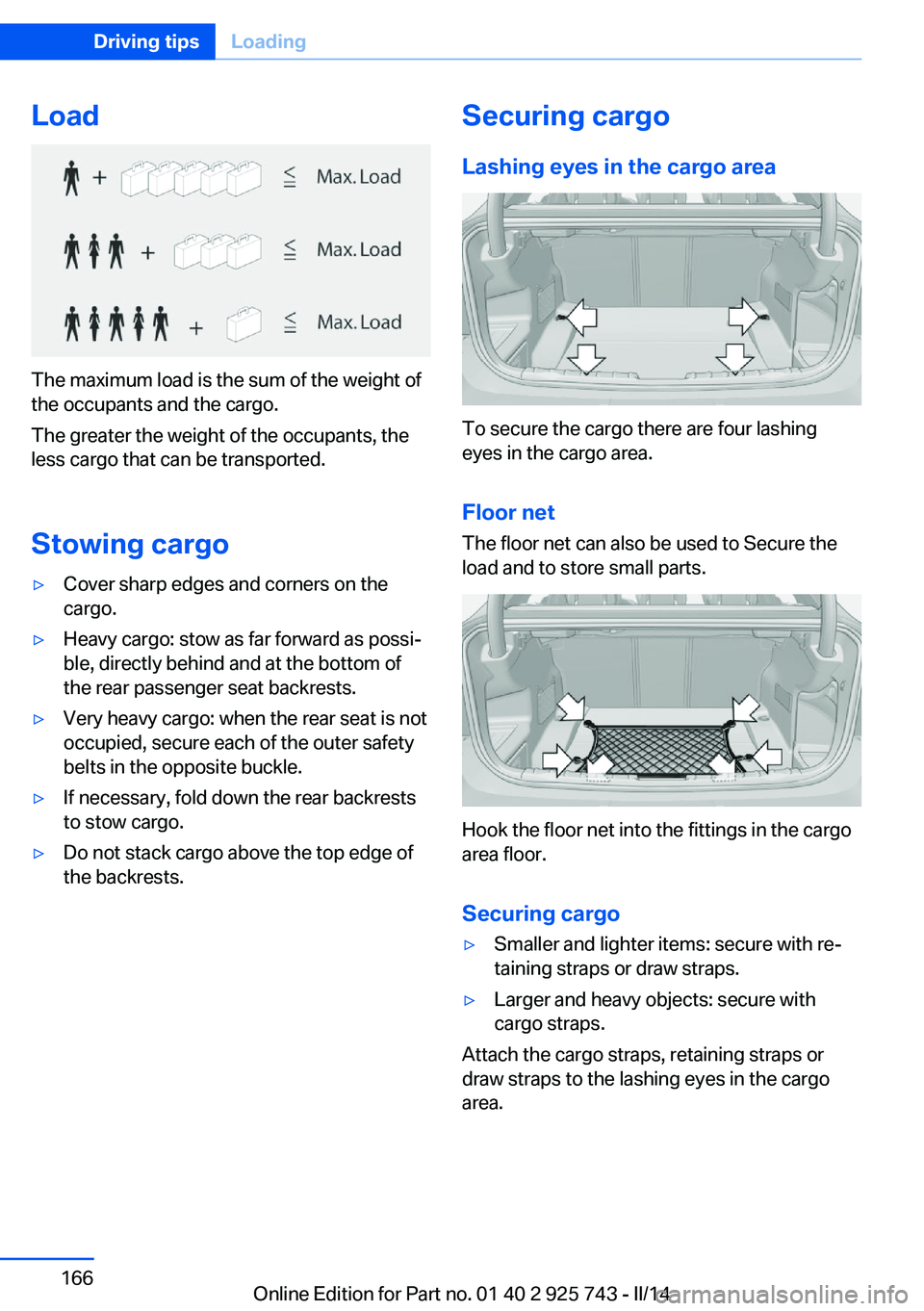
Load
The maximum load is the sum of the weight of
the occupants and the cargo.
The greater the weight of the occupants, the
less cargo that can be transported.
Stowing cargo
âˇCover sharp edges and corners on the
cargo.âˇHeavy cargo: stow as far forward as possiâ
ble, directly behind and at the bottom of
the rear passenger seat backrests.âˇVery heavy cargo: when the rear seat is not
occupied, secure each of the outer safety
belts in the opposite buckle.âˇIf necessary, fold down the rear backrests
to stow cargo.âˇDo not stack cargo above the top edge of
the backrests.Securing cargo
Lashing eyes in the cargo area
To secure the cargo there are four lashing
eyes in the cargo area.
Floor net
The floor net can also be used to Secure the
load and to store small parts.
Hook the floor net into the fittings in the cargo
area floor.
Securing cargo
âˇSmaller and lighter items: secure with reâ
taining straps or draw straps.âˇLarger and heavy objects: secure with
cargo straps.
Attach the cargo straps, retaining straps or
draw straps to the lashing eyes in the cargo
area.
Seite 166Driving tipsLoading166
Online Edition for Part no. 01 40 2 925 743 - II/14
Page 218 of 242

If the first starting attempt is not successâ
ful, wait a few minutes before making anâ
other attempt in order to allow the disâ
charged battery to recharge.3.Let both engines run for several minutes.4.Disconnect the jumper cables in the reâ
verse order.
Check the battery and recharge if necessary.
Tow-starting and towing Note Tow-starting and towing
When tow-starting and towing the vehiâ
cle, switch off the Intelligent Safety systems;
otherwise, improper behavior of the braking
function of individual systems could result in
an accident.â
Switching off Intelligent Safety systems, refer
to page 102.
Manual transmission Gearshift lever in neutral position.
Towing Follow the towing instructions
Follow all towing instructions; otherwise,
vehicle damage or accidents may occur.â
âˇMake sure that the ignition is switched on;
otherwise, the low beams, tail lamps, turn
signals, and windshield wipers may be unâ
available.âˇDo not tow the vehicle with the rear axle
tilted, as the front wheels could turn.âˇWhen the engine is stopped, there is no
power assist. Consequently, more force
needs to be applied when braking and
steering.âˇLarger steering wheel movements are reâ
quired.âˇThe towing vehicle must not be lighter
than the vehicle being towed; otherwise,
it will not be possible to control the vehicle
response.
Tow truck
Your vehicle should be transported with a tow
truck with a so-called lift bar or on a flat bed.
Do not lift the vehicle
Do not lift the vehicle by the tow fitting or
body and chassis parts; otherwise, damage
may result.â
Automatic transmission: transporting
your vehicle
Note Your vehicle is not permitted to be towed.
Therefore, contact a service center in the
event of a breakdown.
Do not have the vehicle towed
Have your vehicle transported on a loadâ
ing platform only; otherwise, damage may ocâ
cur.â
Seite 218MobilityBreakdown assistance218
Online Edition for Part no. 01 40 2 925 743 - II/14
Page 219 of 242

Tow truck
The vehicle should only be transported on a
loading platform.
Do not lift the vehicle
Do not lift the vehicle by the tow fitting or
body and chassis parts; otherwise, damage
may result.â
Use the tow fitting screwed in at the front for
maneuvering the vehicle only.
Towing other vehicles
General information Light towing vehicle
The towing vehicle must not be lighter
than the vehicle being towed; otherwise, it will
not be possible to control the vehicle reâ
sponse.â
Attaching the tow bar/tow rope correctly
Attach the tow bar or tow rope to the tow
fitting; connecting it to other vehicle parts may
cause damage.â
âˇSwitch on the hazard warning system, deâ
pending on local regulations.âˇIf the electrical system has failed, clearly
identify the vehicle being towed by placing
a sign or a warning triangle in the rear winâ
dow.
Tow bar
The tow fittings used should be on the same
side on both vehicles.
Should it prove impossible to avoid mounting
the tow bar at an offset angle, please observe
the following:âˇManeuvering capability is limited during
cornering.âˇThe tow bar will generate lateral forces if it
is secured with an offset.
Tow rope
When starting to tow the vehicle, make sure
that the tow rope is taut.
To avoid jerking and the associated stresses
on the vehicle components when towing, alâ
ways use nylon ropes or nylon straps.
Attaching the tow rope correctly
Only secure the tow rope on the tow fitâ
ting; otherwise, damage can occur when it is
secured on other parts of the vehicle.â
Tow fitting
The screw-in tow fitting should always be carâ
ried in the vehicle. It can be screwed in at the
front or rear of the BMW. It is in the onboard
vehicle tool kit located in a storage compartâ
ment on the right side in the cargo area. Open
the cover.
Tow fitting, information on use
âˇUse only the tow fitting provided with
the vehicle and screw it all the way in.âˇUse the tow fitting for towing on paved
roads only.Seite 219Breakdown assistanceMobility219
Online Edition for Part no. 01 40 2 925 743 - II/14
Page 232 of 242
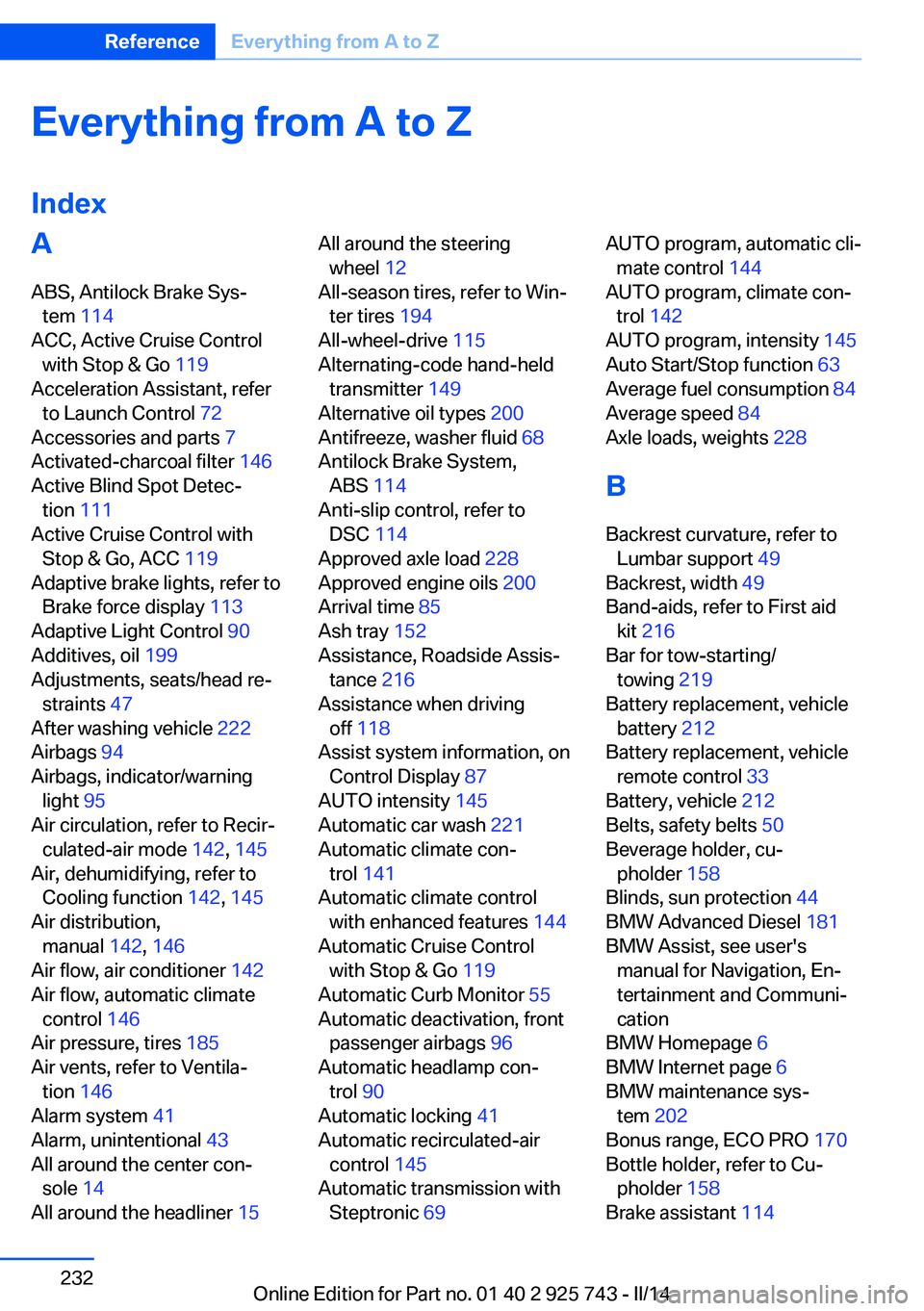
Everything from A to Z
IndexA ABS, Antilock Brake Sysâ tem 114
ACC, Active Cruise Control with Stop & Go 119
Acceleration Assistant, refer to Launch Control 72
Accessories and parts 7
Activated-charcoal filter 146
Active Blind Spot Detecâ tion 111
Active Cruise Control with Stop & Go, ACC 119
Adaptive brake lights, refer to Brake force display 113
Adaptive Light Control 90
Additives, oil 199
Adjustments, seats/head reâ straints 47
After washing vehicle 222
Airbags 94
Airbags, indicator/warning light 95
Air circulation, refer to Recirâ culated-air mode 142, 145
Air, dehumidifying, refer to Cooling function 142, 145
Air distribution, manual 142, 146
Air flow, air conditioner 142
Air flow, automatic climate control 146
Air pressure, tires 185
Air vents, refer to Ventilaâ tion 146
Alarm system 41
Alarm, unintentional 43
All around the center conâ sole 14
All around the headliner 15 All around the steering
wheel 12
All-season tires, refer to Winâ ter tires 194
All-wheel-drive 115
Alternating-code hand-held transmitter 149
Alternative oil types 200
Antifreeze, washer fluid 68
Antilock Brake System, ABS 114
Anti-slip control, refer to DSC 114
Approved axle load 228
Approved engine oils 200
Arrival time 85
Ash tray 152
Assistance, Roadside Assisâ tance 216
Assistance when driving off 118
Assist system information, on Control Display 87
AUTO intensity 145
Automatic car wash 221
Automatic climate conâ trol 141
Automatic climate control with enhanced features 144
Automatic Cruise Control with Stop & Go 119
Automatic Curb Monitor 55
Automatic deactivation, front passenger airbags 96
Automatic headlamp conâ trol 90
Automatic locking 41
Automatic recirculated-air control 145
Automatic transmission with Steptronic 69 AUTO program, automatic cliâ
mate control 144
AUTO program, climate conâ trol 142
AUTO program, intensity 145
Auto Start/Stop function 63
Average fuel consumption 84
Average speed 84
Axle loads, weights 228
B Backrest curvature, refer to Lumbar support 49
Backrest, width 49
Band-aids, refer to First aid kit 216
Bar for tow-starting/ towing 219
Battery replacement, vehicle battery 212
Battery replacement, vehicle remote control 33
Battery, vehicle 212
Belts, safety belts 50
Beverage holder, cuâ pholder 158
Blinds, sun protection 44
BMW Advanced Diesel 181
BMW Assist, see user's manual for Navigation, Enâ
tertainment and Communiâ
cation
BMW Homepage 6
BMW Internet page 6
BMW maintenance sysâ tem 202
Bonus range, ECO PRO 170
Bottle holder, refer to Cuâ pholder 158
Brake assistant 114 Seite 232ReferenceEverything from A to Z232
Online Edition for Part no. 01 40 2 925 743 - II/14
Page 235 of 242

Engine oil types, alternaâtive 200
Engine oil types, apâ proved 200
Engine start during malfuncâ tion 33
Engine start, jump-startâ ing 216
Engine start, refer to Starting the engine 62
Engine stop 62
Engine temperature 78
Entering a car wash 221
Equipment, interior 148
ESP Electronic Stability Proâ gram, refer to DSC 114
Exchanging wheels/tires 193
Exhaust system 163
Exterior mirror, automatic dimming feature 55
Exterior mirrors 54
External start 216
External temperature disâ play 79
External temperature warnâ ing 79
Eyes for securing cargo 166
F
Failure message, refer to Check Control 76
False alarm, refer to Unintenâ tional alarm 43
Fan, refer to Air flow 142, 146
Fault displays, refer to Check Control 76
Filler neck for engine oil 199
Fine wood, care 223
First aid kit 216
Fitting for towing, refer to Tow fitting 219
Flat tire, changing wheels 212
Flat Tire Monitor FTM 100 Flat tire, Tire Pressure Moniâ
tor TPM 97
Flat tire, warning lamp 98, 101
Flooding 163
Floor carpet, care 224
Floor mats, care 224
Fogged up windows 142
Fold down the rear seat backâ rest, see Though-loading
system 154
Fold-out position, windshield wipers 68
Foot brake 163
Front airbags 94
Front fog lamps 92
Front fog lamps, bulb replaceâ ment 209
Front lamps 205
Front passenger airbags, auâ tomatic deactivation 96
Front passenger airbags, indiâ cator lamp 96
FTM Flat Tire Monitor 100
Fuel 180
Fuel cap 178
Fuel consumption, current 80
Fuel consumption, refer to Average fuel consumpâ
tion 84
Fuel filler flap 178
Fuel gauge 78
Fuel quality 180
Fuel recommendation 180
Fuel, tank capacity 231
Fuse 213
G
Garage door opener, refer to Universal garage door
opener 148
Gasoline 180
Gear change, automatic transmission 70
Gear shift indicator 81 General driving notes 162
Glass sunroof, powered 45
Glove compartment 156
Gross vehicle weight, apâ proved 228
H
Handbrake, refer to parking brake 65
Hand-held transmitter, alterâ nating code 149
Hazard warning flashers 215
Head airbags 94
Headlamp control, autoâ matic 90
Headlamp courtesy delay feaâ ture 89
Headlamp flasher 66
Headlamp glass 205
Headlamps 205
Headlamps, care 222
Headlamp washer system 66
Headliner 15
Head restraints 47
Head restraints, front 51
Head restraints, rear 52
Head-up Display 87
Head-up Display, care 224
Heavy cargo, stowing 166
Height, vehicle 228
High-beam Assistant 91
High beams 66
High beams/low beams, refer to High-beam Assistant 91
Hills 164
Hill start assistant, refer to Drive-off assistant 118
Hints 6
Holder for beverages 158
Homepage 6
Hood 197
Horn 12
Hotel function, trunk lid 38
Hot exhaust system 163
HUD Head-up Display 87 Seite 235Everything from A to ZReference235
Online Edition for Part no. 01 40 2 925 743 - II/14